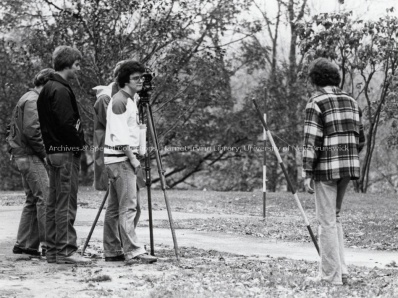Department of Geodesy and Geomatics Engineering
Previously named: Surveying Engineering
Established: 1965
History: Geodesy and Geomatics Engineering at the University of New Brunswick has a long history that goes back to the University's introduction of engineering in the mid-1800s, but it is more often recognized for its significant developments in the latter half of the twentieth century.
Instruction in surveying began in 1854, technically under the Civil Engineering course at the University of New Brunswick. By 1909, it was listed under the Department of Applied Science with four course offerings. These courses included Land Surveying, Railway and Highway Construction, Tunnelling, and Astronomy. Surveying was soon offered in all four years by 1913. There were six courses by 1920 including Railroad Economics. For the next two decades, the Surveying curriculum essentially remained the same, offering only four courses again by 1942. These courses were listed under the Department of Applied Science and remained associated with Civil Engineering for the first half of the twentieth century.
A Bachelor of Science in Surveying Engineering was offered in 1960, though still under the Department of Civil Engineering. A Ph.D. program was established in 1963. It remained a significant component of the Civil Engineering curriculum, although administrated separately by 1964, until its official departmentalization in November 1965. The curriculum underwent many changes in the 1960s and 1970s and course offerings expanded to twenty-five undergraduate courses and fifteen graduate courses by 1970. The first two Ph.D. degrees were awarded in the 1969-70 academic year. Fourteen instructors worked in the Department at this time. Some of the newer courses offered included Engineering Management, Survey Camp, Adjustment Computations, Technical Photography, Geometric Geodesy, and Cartographic Drawing. Significant developments in the Department occurred more frequently in the 1970s, and sub-sections were created to allow for more specification within the curriculum. They were Surveying, Adjustments, Geodesy, Photogrammetry, Cartography, Cadastre and Survey Systems, Reports, Technical Elective Courses, and Service Courses. Enrollment in the Department also grew significantly in the mid-1970s, largely due to an increasing number of transfer students. The Department offered forty-four courses in 1983. By the early 1990s, a Cadastral Surveying option within Surveying Engineering was added to the degree program. Students were also able to receive a Certificate of Academic Proficiency in Hydrographic Surveying. Four more courses were added to the curriculum in the 1992-93 academic year, bringing the total to forty-eight. By 1993, a Certificate of Field Proficiency in Hydrographic Surveying was added. Students were able to apply for this certificate after receiving the first one in academic proficiency.
In 1994, the Department of Surveying Engineering became the Department of Geodesy and Geomatics Engineering. This new name was more accurately representative of the Department's modern features. That same year, the Department also began offering diploma programs in certain specializations. There were five programs: Cadastral Studies, Engineering and Exploration Surveying, Geodetic Surveying, Land Information Management, and Mapping and Geographic Information Systems. In the 1995-96 year, there were fifteen instructors working for the Department. There were forty-nine courses offered by 1997, specifically made up of twenty-six core courses, sixteen technical elective courses, and seven service courses. Students could receive concurrent degrees in Geodesy and Geomatics Engineering and Computer Science by 1998. These degrees made it possible for students to graduate with both Bachelor of Science in Civil Engineering and Bachelor of Computer Science degrees in six years. Course offerings dropped to thirty-eight by 2000. Newer course offerings in the early 2000s included Marine Policy, Law and Administration, Hydrographic Surveying Operations, Geographic Information Systems, Gravity Field and Geodetic Networks, and Remote Sensing. Course offerings were altered slightly through the decade and by 2008, there were forty-six courses and twenty-three instructors. In the 2012-13 academic year, the Department had nineteen instructors and offered fifty-one courses including Survey Law, Industrial Metrology, Tides and Water Levels, and Digital Image Processing.
Physical location: Sir Edmund Head Hall
Faculty: Engineering
Notes: The Brydone Jack Observatory, constructed by professor William Brydone Jack in 1851, was designed for both general instruction in astronomy and surveying measurements.
Around 1874, Brydone Jack had a stone pillar, known as the Meridian Pillar, installed on the campus, meant to determine a true median line. This allowed for more effective use of land surveying equipment and technology.
The year that a certain department was established can be a subjective figure. For the purpose of this wiki, the year that a department is considered first established is the first year it was listed in the academic calendar as an independent chair with no other affiliation, unless documentation can demonstrate otherwise.
Source(s):
- Baird, A. Foster. “The History of Engineering at the University of New Brunswick”. The University of New Brunswick Memorial Volume. Ed. Alfred G. Bailey. Fredericton: University of New Brunswick, 1950. 75-86.
- UA Case 100; Sections 1, 5.
- UNB Calendars (UA RG 86) 1909, 1913, 1920, 1942-43, 1961-62, 1969-70, 1970-71, 1976-77, 1983-84, 1990-91, 1992-93, 1993-94, 1994-95, 1997-98, 1998-99, 2000-01, 2004-05, 2008-09, 2012-13.
- Wade, Scott and Hugh Lloyd. Behind the Hill. Fredericton: Published by the Students’ Representative Council, the Associated Alumni and the Senate of the University of New Brunswick, 1967.
--HollyMiller 5 March 2013 (ADT)
© UNB Archives & Special Collections, 2014
